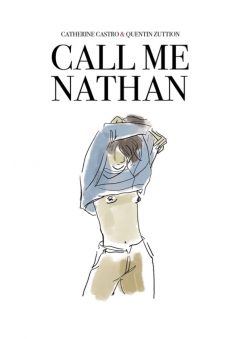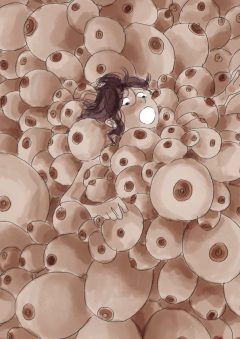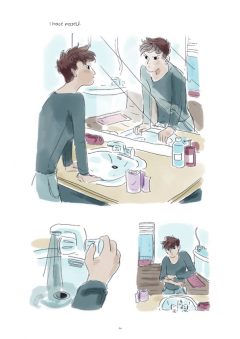Review: Call Me Nathan (Self Made Hero)
‘What is it, being a man? Do stars have a gender?’ Call Me Nathan from Catherine Castro and Quentin Zuttion follows Nathan’s journey through self-discovery and gender identity from a confused teenage girl to a confident man. Will this be another stellar read about serious issues from SelfMadeHero? Let’s find out!
 Publisher: SelfMadeHero
Publisher: SelfMadeHero
Writer: Catherine Castro
Artist: Quentin Zuttion
Price: Pre-order from Amazon for £14.99
Based on a true story, Call Me Nathan takes a retrospective look at Nathan’s life from a young child to a man. Nathan was born a female, named Lila, and now identifies as a trans male. Throughout this graphic novel, we are given glimpses into Nathan’s past, what formed his identity and how he became the man he is today.
Our first glimpse into Nathan’s childhood highlights early issues he faces in his gender identity. At first glance, these may seem minuscule – like not liking the Hello Kitty bag he gets for Christmas or disliking wearing a dress. But as the graphic novel continues, we see that it’s not necessarily just the stereotypes of being a girl that Nathan struggles with (liking pink, wearing girly clothes, etc.); it’s the actual biology of being female that he finds uncomfortable, even as a child. But it is when he hits puberty that he really begins to struggle with his body. Nathan recalls an instance in his early teenage years in which he first feels self-conscious about having developed breasts. ‘You disgust me’, Nathan says into the mirror, as he looks at his own developing body.
 Nathan’s inner battle further manifests at school and home: at school he becomes fascinated with finding out more about the process of male puberty, and at home he begins to wear his brothers’ clothes rather than his own (a point of contention). Nathan finds himself dreading school swimming lessons as he is so self-conscious of his own body, looking enviably at the boys who can effortlessly show off their muscles, leg hair and armpit hair. Quentin Zuttion does a stellar job here of depicting how overwhelmed and alien Nathan feels in his own body. Drawing on the setting of the swimming pool, Zuttion constructs a motif for drowning, and how Nathan is drowning in his own body. In a startling image, Nathan appears to be suffocating beneath a huge mass of breasts, which eventually overcome him, and he is lost.
Nathan’s inner battle further manifests at school and home: at school he becomes fascinated with finding out more about the process of male puberty, and at home he begins to wear his brothers’ clothes rather than his own (a point of contention). Nathan finds himself dreading school swimming lessons as he is so self-conscious of his own body, looking enviably at the boys who can effortlessly show off their muscles, leg hair and armpit hair. Quentin Zuttion does a stellar job here of depicting how overwhelmed and alien Nathan feels in his own body. Drawing on the setting of the swimming pool, Zuttion constructs a motif for drowning, and how Nathan is drowning in his own body. In a startling image, Nathan appears to be suffocating beneath a huge mass of breasts, which eventually overcome him, and he is lost.
No one likes getting their period, but for Nathan it’s a lot more complex than pain and inconvenience. Nathan getting his period sickens him to the core. He tries to hide it from those around him, including his parents, and is disgusted when his mother sees the transition as a good thing, as part of ‘becoming a woman’. The thing is, Nathan isn’t disgusted by the female body. In fact, he finds himself hugely attracted to females sexually, especially his girlfriend Faustine. It is Faustine who first suggests that Nathan may be transgender, as he questions if he is a lesbian: ‘you like girls, but really you’re a guy’.
The art by Quentin Zuttion is truly exceptional. Each panel is detailed, colourful and visually stunning. The facial expressions, particularly those of Nathan, are done with great care and consideration, and visually tell his story without even needing to read the accompanying words. They appeared almost anime-esque at times due to their detail. The beautiful backgrounds were another highlight, especially those including nature, with swooping curls of watercolor and pastel.
 The graphic novel does feature some graphic imagery, including (trigger warning) self-harm to the wrists, some bloody panels of Nathan literally ripping his breasts from his chest, and a graphic depiction of the body parts removed in gender reassignment surgery. While this may be too gory for some, it really drives home the point that Catherine Castro is trying to make about struggling with gender identity; I think that this is a wake-up call for most people to how traumatic wrestling with your identity and hating your own body can be. This all comes to a climax in which Nathan’s parents confront him, and question whether he wants to be a boy. His response? ‘I am a boy. Call me Nathan’.
The graphic novel does feature some graphic imagery, including (trigger warning) self-harm to the wrists, some bloody panels of Nathan literally ripping his breasts from his chest, and a graphic depiction of the body parts removed in gender reassignment surgery. While this may be too gory for some, it really drives home the point that Catherine Castro is trying to make about struggling with gender identity; I think that this is a wake-up call for most people to how traumatic wrestling with your identity and hating your own body can be. This all comes to a climax in which Nathan’s parents confront him, and question whether he wants to be a boy. His response? ‘I am a boy. Call me Nathan’.
From then, we follow Nathan’s journey through therapy, taking testosterone and eventually surgery. It was fascinating to find out so much about the hugely long and painful process trans people must go through before having any surgery; I was particularly shocked by the cost of the surgery alone, which was £35,000, without other expenses being considered. This read was an illuminating look into the mind of someone suffering with gender dysphoria and makes a truly thorough and detailed resource for anyone interested in learning more about the subject. Bravo!



September 7, 2025 @ 5:40 am
Your point of view caught my eye and was very interesting. Thanks. I have a question for you.
October 8, 2025 @ 3:12 pm
This helped me a lot, thank you. Stay with equidia direct — live horse racing and Quinté+ focus. HD streams with low latency. racecards and odds, post‑race highlights. clean interface with instant access.
November 29, 2025 @ 9:51 pm
onlinegames
References:
https://uznev.uz/user/bandarlflw
October 11, 2025 @ 2:29 pm
order Stromectol discreet shipping USA: Stromectol ivermectin tablets for humans USA – Mediverm Online
November 30, 2025 @ 12:49 am
net casino
References:
https://www.golf-bookmarks.win/radware-s-new-captcha-solution
November 30, 2025 @ 9:31 pm
manoir industries
References:
https://elitetier.club/read-blog/6516_20-best-online-casinos-in-australia-for-real-money.html
December 1, 2025 @ 2:59 am
ipad online
References:
http://www.career4.co.kr/bbs/board.php?bo_table=ci_consulting&wr_id=319901
December 1, 2025 @ 3:53 pm
river palms casino laughlin
References:
https://selfloveaffirmations.net/@xaviermajors66
December 2, 2025 @ 8:58 pm
online roulette game
References:
http://appyet.com/handler/disqus.ashx?guid=713ae0d41568487bb47b9d09585fe482&id=45fee95b8971b2435e0570d007b5f281&locale=ar&shortname=aqoal&title=&type=1&url=https://www.insert-bookmark.win/dining-albuquerque-downs-casino
December 3, 2025 @ 1:41 am
the isle casino
References:
https://www.hungama.site/member.php?action=profile&uid=20289
December 4, 2025 @ 9:21 pm
Mit optimierter Leistung und einfacher Steuerung bleibt das Gameplay immer erstklassig, auch wenn Sie von mobilen Geräten aus spielen. Für Fans klassischer Spiele bietet das Casino eine umfangreiche Auswahl an Tischspielen. Das Casino kombiniert klassische Casinospiele mit modernen Innovationen und bietet eine große Auswahl an Slots, Tischspielen und Live-Dealer-Spielen. Ja, das NV Casino bietet eine mobile App, mit der Sie direkt auf Ihrem Smartphone oder Tablet spielen können. Die mobile Plattform ist so konzipiert, dass sie den Spielern ein reibungsloses und unterhaltsames Erlebnis bietet, egal ob sie auf einem Smartphone oder einem Tablet spielen. Genießen Sie lohnende Einzahlungsboni, exklusives Cashback sowie den Nervenkitzel von Freispielen und Sonderaktionen. Das Casino bietet eine sichere und faire Spielumgebung und ist bekannt für seine zahlreichen Boni und Aktionen, darunter der begehrte NV casino bonus.
Die Mindesteinzahlung bei NVCasino beträgt 10 €, und alle Einzahlungen werden sofort gutgeschrieben. NV Casino bietet eine Vielzahl sicherer und bequemer Zahlungsmethoden für Ein- und Auszahlungen. Stattdessen bietet die mobile Version der Website eine vollständig optimierte und nahtlose Spielerfahrung, die einer App in nichts nachsteht. Für Spieler, die gerne höhere Beträge setzen, bietet NVCasino einen speziellen Highroller Bonus.
References:
https://online-spielhallen.de/nine-casino-uk-150-150-freispiele-premium-gaming/
December 5, 2025 @ 12:04 am
So stehen Ihnen beispielsweise bei einem Willkommensbonus von 100% bis zu einem Betrag von 1.000 Euro maximal 2.000 Euro zum Spielen zur Verfügung. Um Ihnen den Spieleinstieg beim Online Glücksspiel um echtes Geld zu erleichtern, haben wir uns bei unserer Recherche im Internet auch auf Casinos mit den besten und größten Willkommensboni konzentriert. Neben „The Hoff“ glänzt die Online Spielhalle aber noch mit einem top Spieleangebot von mehr als 1.000 Spielen von über 50 Slot Providern sowie schnellen Auszahlungen innerhalb von 1-5 Werktagen. Bereits im Jahr 2022 hat das BingBong Casino die deutsche Lizenz erhalten und macht es sich seitdem zur Aufgabe im Social Media Outfit ein jüngeres Publikum anzusprechen. Das äußert sich nicht nur im sehr guten Kundenservice, sondern auch bei Spieleauswahl und Zahlungsmitteln. Wir haben für Sie die besten Echtgeld Online Casinos für 2025 in dieser Übersicht zusammengestellt.
Folgend haben wir dir nochmals die wichtigsten Key-Facts zu den besten, seriösen Online Casinos im Sicherheitscheck zusammengestellt. Die entsprechenden Prüfberichte kannst du dann auf der Webseite des Spielanbieters abrufen. Die besten Online Casinos arbeiten durchschnittlich mit einem Return To Player von ca.
References:
https://online-spielhallen.de/casino-bonus-ohne-einzahlung-2025-gratis-casino-boni/
December 5, 2025 @ 2:16 am
Zum Beispiel können die Mindesteinzahlungen und Umsatzbedingungen variieren. Hit’n’Spin Casino bietet großartige Boni und Aktionen, um Ihr Spielerlebnis zu verbessern. Bis zu 800 Euro + 200 Freispiele200 % Cashback und 100 FS wöchentlich Hitnspin Casino bietet ein Cashback-Programm für seine Spieler. Die Plattform ist für die mobile Nutzung optimiert, es gibt jedoch keinen speziellen Code, um den Bonus zu erhalten. Bei der dritten Einzahlung gibt es für die Einzahlung 100% als Spielguthaben bis zu 200€ und 50 Freispiele für Joker Stoker.
Das benutzerfreundliche Design macht es einfach, Ihre Lieblingsspiele zu finden und Boni zu verwalten. In der höchsten Stufe erhalten Sie 200 % Bonus sowie 100 Freispiele für die Einzahlung. Um den Einzahlungsbonus zu erhalten, müssen Sie pro Zahlung mindestens 10€ aufladen. Um Gewinne aus dem No Deposit Bonus zu erhalten, müssen Sie die Freispiele bzw. Wie viele andere Casinos auch bietet Hitnspin natürlich auch einen Einzahlungsbonus. Beim zweiten Teilbonus profitieren Sie nämlich mit einer Mindesteinzahlung von 35 € aufwärts von einer größeren Bonussumme. Man profitiert auch bei den beiden nachfolgenden Einzahlungen von einem Bonusgeld und Freispielen.
References:
https://online-spielhallen.de/boomerang-casino-deutschland-test-bonus-bis-zu-500e/
December 5, 2025 @ 12:53 pm
Zusätzlich zum Willkommensbonus bietet Ice Casino neuen Spielern 100 Freispiele auf ausgewählte Spielautomaten. Aus diesem Grund hat Ice online casino ein einzigartiges Treueprogramm für seine Stammkunden geschaffen. Wie bei anderen Ice Casino-Boni ohne Einzahlung ist nichts weiter erforderlich, um Freispiele zu erhalten, als sich zu registrieren und ein neues Spielerkonto zu verifizieren. Sie müssen nicht nur mit einem bestimmten Gerät spielen und die von Ice Casino online angebotenen Dienstleistungen in Anspruch nehmen.
Der maximale Cashback-Betrag, den Sie erhalten können, beträgt 2000 €. Je nach Ihrer Treuestufe erhalten Sie zwischen 3% und 12% Cashback. Wenn Sie die höchste Stufe erreichen und 200 € einzahlen, erhalten Sie einen 180 €-Bonus. Der maximale Bonusbetrag, den Sie jede Woche erhalten können, beträgt 200 €.
References:
https://online-spielhallen.de/die-9-besten-online-casinos-deutschland-2025-top-guide/
December 7, 2025 @ 9:16 am
online games casino
References:
https://motionentrance.edu.np/profile/startrod2/
December 7, 2025 @ 1:47 pm
kickapoo casino shawnee
References:
https://maps.google.com.sl/url?q=https://case.edu/cgi-bin/newsline.pl?URL=https://blackcoin.co/playcroco-casino-a-comprehensive-review/
December 20, 2025 @ 11:21 am
Spielen Sie ausschließlich in lizenzierten Casinos und nutzen Sie die angebotenen Tools für verantwortungsvolles Spielen, wie Einsatzlimits oder Spielpausen. No-Limit-Casinos entfernen Einsatz- und Gewinnlimits, bieten damit maximale Flexibilität und die Chance auf besonders hohe Auszahlungen. Des Weiteren können neue Spielerinnen und Spieler mit einem ansprechenden Willkommensbonus bis zu 500 Euro und 200 Freispielen durchstarten (prüfe immer die Bedingungen). Es obliegt Ihrer Verantwortung, Ihre lokalen Bestimmungen zu prüfen, bevor Sie online spielen. Casinos mit deutscher Lizenz werden mit Einzahlungslimits und Setzlimits einhergehen.
Wenn Sie nur mit 10 Euro spielen möchten, finden Sie hier Online-Casinos mit einer Mindesteinzahlung von 10 Euro oder auch 10€ ohne Einzahlung. Daher kommt es vor, dass es je nach gewählter Spielbank unterschiedliche Höchstlimits für denselben Automaten gibt. Die meisten von Live Dealer Tischen haben Tischlimits für Mindest- und Höchsteinsätze. 1 € ist jedoch niedriger als der durchschnittliche Einsatz für Spieler, selbst wenn sie nicht groß spielen.
References:
https://online-spielhallen.de/ihr-ultimativer-leitfaden-jet-casino-bonus-code/
December 26, 2025 @ 6:05 pm
A license means the casino is regularly audited, follows fair gaming rules, and protects player funds. With the right tips and a sharp eye, you can easily separate the real-deal casinos from the ones that don’t deserve your time — or your money. Add to that the solid withdrawal system, wide game variety, and generous bonuses, and it’s easy to see why more Australians are calling this place home. As you can see, National Casino isn’t just about spinning a few reels — it’s a full-featured platform designed with Aussie players in mind. National is licensed, fully optimised for mobile, and packed with high-quality games from top developers. Whether you’re in Sydney, Melbourne, or anywhere else across Australia, this online casino is well worth checking out — even if you’re just getting started in the world of online gambling.
Australian players can choose from over 100 different table game options. Australian players have won significant jackpots through our platform, with prizes paid out within our standard timeframes. We negotiate these special terms to give our Australian players better value and unique gaming experiences. Monday free spins give you weekly opportunities to play popular slot games without using your own funds. Our Monday free spins promotion gives existing players complimentary spins without requiring additional deposits. We currently focus our promotional efforts on deposit-based bonuses rather than no deposit offers.
National Casino collaborates with the best software providers in the gambling market. This feature moves the gamers to the most exciting part of a game and they don’t have to spin and wait for the cherished winning combinations. Adrenaline junkies will enjoy fun jackpot pokies playing Playtech´s Gladiator Jackpot slot. What is attractive is that it´s not only a money prize, but also free spins for some slot machines. National Casino gives Australian gamblers a nice welcome bonus to motivate and encourage them upon signing up. National Casino has successfully entered a gambling market in Australia.
References:
https://blackcoin.co/craps_strategie/
December 26, 2025 @ 9:27 pm
All jackpots, video slots, and live games load quickly without lag. Just open your phone’s browser, log in, and you’re ready to spin pokies or join a live dealer table within seconds. The casino platform is fully optimised for both Android and iOS, so you don’t need to download heavy software or clunky apps. Licensed platform with advanced security and responsible gaming tools.
Sky crown casino developed this cashback system after seeing how quickly bankrolls can disappear during unlucky sessions. Use these funds immediately on any game across the platform. The system handles everything behind the scenes – calculating losses and crediting the bonus without any action required. Players wake up to find 10% of net losses returned directly to their casino account. After a rough streak at Sky crown casino, the sting hurts less knowing some money comes back automatically. When you continue your journey after the first deposit, even more rewards await you.
Details regarding bonuses are posted on the official website and within your individual account, keeping you informed of the latest available opportunities. Dedicated customers can also join the rewards scheme, where unique perks and customized bonuses are granted for ongoing engagement. Notable bonus features include welcome deals, complimentary spins, cashback rewards, and contests featuring significant prize pools.
References:
https://blackcoin.co/spanish-21-rules/
December 29, 2025 @ 7:06 am
online pokies paypal
References:
https://jobsbotswana.info/companies/best-paypal-casinos-usa-%E1%90%88-top-real-money-paypal-casinos/
December 29, 2025 @ 7:28 am
mobile casino paypal
References:
https://ispd.org/?post_type=dwqa-question&p=37575
January 2, 2026 @ 10:41 am
Your article helped me a lot, is there any more related content? Thanks!